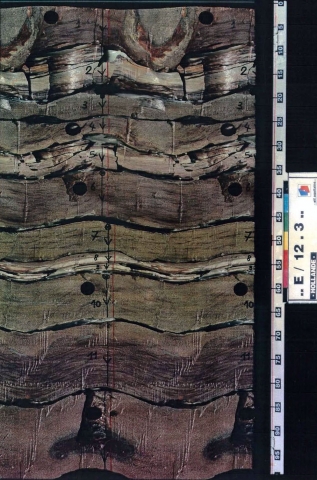Alternation of white, light-grey or pink, massive, carbonaceous sandstones, dark- (brownish) grey to black silt- and mudstones and frequent coal seams. In the basal interval the formation displays a characteristic pattern of stacked coarsening-upward sequences. In the younger part, this pattern changes into combined fining- and coarsening-upward sequences. Sandstones are stacked channel fills, forming sheets of 3 to 25 m thick. These are concentrated in the tops and bases of the depositional cycles. Sandstones largely consist of argillaceous, subangular, moderately- to well-sorted, very fine- to coarse-grained sand. At some intervals, the sands are conglomeratic and devoid of argillaceous matrix. Mudstone intervals are silty or very fine-grained sandy and carbonaceous. Cored intervals show small-scale coarsening-upward cycles, capped by sand/ siltstone beds, coal seams or seat earths. Coal seams are rarely up to 3 m thick, and constitute 1 to 5% of the formation.
Alternation between poorly-drained delta plain and lacustrine basin, with occasional marine incursions (Guion 1988; Cowan 1989; Collinson 1993).
The base of the sandstone bed underlying the deepest coal seam, or the lowermost coal seam if no sandstone is developed. The deposits of the underlying Millstone Grit Formation are similar, but lack the coal seams.
Overlain conformably by the Maurits Formation. At this boundary the succession changes abruptly to a thick mudstone interval, generally with abundant intercalated coal seams.
